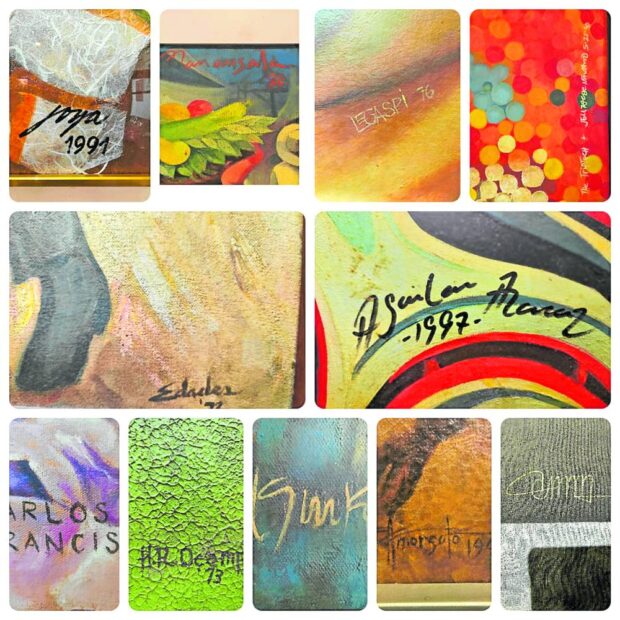
UNDER ONE ROOF | The newly opened Museum of Philippine Arts and Culture (Mopac) features the major works of 11 national artists for visual arts, enough reason to visit the City of San Fernando in Pampanga province to view the collection. (CONTRIBUTED PHOTO)
CITY OF SAN FERNANDO, Pampanga, Philippines — Clad in a red dress and beaming with pride, museum curator Andrea Domingo greeted guests who came for the blessing of her foundation’s Museum of Philippine Arts and Culture (Mopac) in this Pampanga capital on July 1 to see the featured works of various national artists.
Domingo guided some of her guests to specific artworks and, when time allowed, gave some backstories or explained the art styles. The more enthusiastic ones were told to turn off their camera flashes when taking pictures of the exhibit.
Found in Mopac’s galleries are works by 11 of the country’s national artists for visual arts: Fernando Amorsolo (proclaimed in 1972), Carlos “Botong” Francisco (1972), Victorio Edades (1976), Vicente Manansala (1981), Cesar Legaspi (1990), Hernando Ocampo (1991), Arturo Luz (1997), Jeremias Elizalde Navarro (1997), Ang Kiukok (2001), Federico Aguilar Alcuaz (2009) and Jose Joya (2003).
The artworks of Presidential Medal of Merit awardees such as Anita Magsaysay-Ho and Mauro “Malang” Santos are given prominence in the first building of the museum.
In the second building are arrays of metal-age pottery, sculptures of santo (saints), excavated Chinese trade wares, Spanish-era jewelry, prewar furniture, and tribal cultural objects from the Cordilleras and Mindanao.
To Domingo, Mopac is all about “sharing with the public” the Filipino identity that drove her to collect the pieces in the past 50 years.
PRECIOUS PIECES Paintings of National Artists Hernando Ocampo and Carlos “Botong” Francisco (below) are among the precious pieces displayed at Mopac. —PHOTOS BY TONETTE T. OREJAS
‘Soul of youth’
She says she intends to “help complete the soul of the youth” in her home province, whose access to the internet and high-tech gadgets is weaning them away from the arts, literature and culture.
Domingo and her husband Rolando collected troves of artworks and artifacts, a lot of them while she was curator and owner of Galerie Andrea Arts and Antique Shop in Intramuros, Manila, for 26 years.
Some were borrowed from other collectors.
They found time to prepare the displays right after Domingo’s stint as chair of the Philippine Amusement and Gaming Corp.
“At least, the collections are not anymore scattered at home,” said her son, Dr. Eric Domingo, who now works with the World Health Organization.
One of the guests during the museum opening, businessman Jose “Jay” Carlos, called Mopac’s location in this city and in Pampanga province a “welcome development.”
Melanie Viloria-Briones, vice president for academic affairs at the City College of San Fernando, said in an interview that she was “amazed with the rare and marvelous collections in Mopac.”
“They are really treasures, and they brought me and my daughter to some of the significant periods in the past. These collections must really be shared and seen,” Briones said.
RELIGIOUS ART Antique wooden images of saints are neatly stacked in glass cabinets at Mopac as reminders of the Filipino’s faith. —MARNA DEL ROSARIO/CONTRIBUTOR
For sharing
She added: “Also, for the education sector, bringing the students here will allow the learners to witness some of the items that they only see as texts and images in books and on the net.”
Robby Tantingco, director of the Center for Kapampangan Studies (CKS) at the Holy Angel University (HAU), said: “Every community should have as many museums as hospitals and churches—family museums, company museums, village museums, town museums—because the past is our collective responsibility to preserve.”
Domingo, who is also the foundation’s chair, said the opening of the museum was the realization of a decadeslong dream.
“I feel that my constant prayer for a peaceful and productive retirement has been fulfilled as well,” she said.
Mopac could “easily rival major museums and galleries in Manila,” Alex Castro, one of the curators of museums at CKS, said in a separate interview at the event.
“Never have I seen an assembly of artworks from so many national artists under one roof. Now, no one has to go to Manila to view the great works of Amorsolo, Manansala, Francisco, Edades, Magsaysay-Ho, Kiukok, Legaspi and Joya—they’re all in here,” Castro said.
ARTIFACTS An entire floor at Mopac is devoted to rare artifacts, including cultural objects, such as “bulul” (Ifugao rice granary guardian, right) from the Cordillera region and textiles from southern Philippines. —PHOTOS BY TONETTE T. OREJAS
Diverse selection
“For the first time, a museum in Pampanga offers a diverse selection of rarely seen artifacts like old religious art, tribal art, colonial jewelry and even trade jars and pottery diggings,” he added.
Pampanga, Castro pointed out, is “privileged to have Mopac in its midst; there’s everything for everyone here—be they museum fans, art aficionados or history buffs.”
Currently, there are five bigger museums in Pampanga.
The museums in Angeles City are the Museo ning Angeles, Museum of Philippine Social History and CKS museums (Mt. Pinatubo, National Artist Vicente Manansala and Kapampangan items) in HAU; the Museong Kapampangan, which is temporarily housed in Clark Museum inside the Clark Freeport; and the Museum of the Archdiocese of San Fernando in the University of the Assumption here.
Except for the social history museum, the rest are run by private foundations.
The Museo ning Angeles was declared by the National Museum an important cultural property.
Catholic parishes in Bacolor and Guagua towns operate small museums, while the local government in San Luis keeps a small room for the mementos of Hukbo ng Bayan Laban sa Hapon (Hukbalahap) leader Luis Taruc.
The City of San Fernando has converted an old train station into a museum of mostly World War II memorabilia.